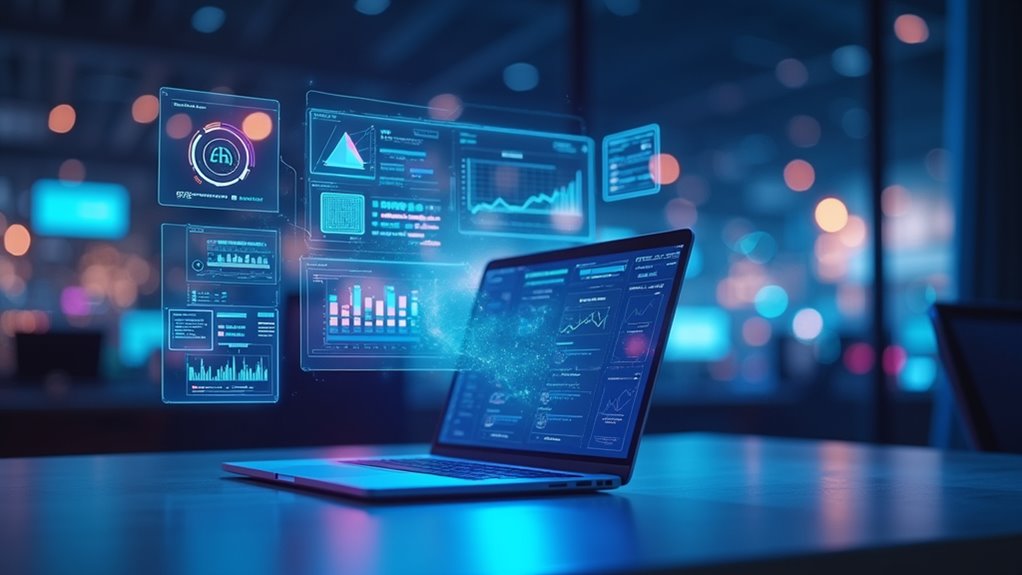AI transforms banking security by continuously monitoring transactions in real time. These smart systems analyze your spending patterns and instantly flag unusual activity—no more frustrating false alarms or undetected fraud. Using behavioral biometrics, AI recognizes how you uniquely interact with devices, making it nearly impossible for scammers to mimic your digital fingerprint. Banks now catch suspicious transactions before damage occurs, not after your money disappears. The future of financial security just got a whole lot smarter.

While criminals constantly devise new schemes to steal your money, banks are fighting back with artificial intelligence that never sleeps.
Today’s financial institutions deploy sophisticated machine learning algorithms that continuously analyze your spending habits, location data, and transaction timing. These digital guardians don’t just follow rigid rules—they actually learn and evolve. When that coffee shop purchase at 3 PM feels normal but a $2,000 electronics buy at 3 AM doesn’t, transaction monitoring systems flag the anomaly instantly. Adaptive authentication systems can immediately trigger additional verification steps when suspicious behavior is detected.
Remember when fraud detection meant getting an awkward call days after your credit card was compromised? Those days are thankfully gone. Modern AI processes vast amounts of data in milliseconds, not days. It’s like having a financial bodyguard who knows you prefer shopping on Tuesdays, never buy jewelry online, and typically spend under $200 per transaction. When something breaks this pattern—boom—the AI springs into action before criminals can do serious damage.
AI in banking doesn’t just protect—it learns your financial habits and stops fraud before damage occurs.
Banks now employ behavioral biometrics that recognize how you typically interact with your devices. The way you type, hold your phone, or navigate websites creates a unique profile that’s surprisingly difficult to fake. Even if someone steals your password, they can’t mimic your digital body language. Unlike traditional rule-based systems that require frequent manual updates, AI-based solutions automatically adapt to emerging fraud threats without requiring complete redesign.
The integration of blockchain technology has added another layer of protection by creating tamper-proof transaction records. Try to alter these records, and the system immediately identifies the inconsistency. Meanwhile, deep learning models continuously adapt to new threats, ensuring yesterday’s solutions remain effective against tomorrow’s attacks. This represents a significant improvement in operational efficiency while simultaneously reducing human error in fraud detection processes.
For customers, this invisible shield means fewer false alarms and greater peace of mind. Your legitimate transactions proceed smoothly while suspicious ones get stopped in their tracks.
The next time your card is declined for an unusual purchase, don’t get annoyed—thank the AI that’s working overtime to protect your financial life. It might be a minor inconvenience, but it’s infinitely better than discovering your account has been drained.
Frequently Asked Questions
How Does AI Balance Fraud Detection With Customer Convenience?
AI algorithms balance fraud detection with customer convenience through sophisticated risk assessment techniques.
They analyze transaction patterns silently in the background—you won’t even notice them working! These systems assign risk scores that trigger security measures only when truly necessary, preserving a smooth customer experience for legitimate transactions.
What Ethical Concerns Arise From AI Fraud Detection Systems?
AI fraud detection systems raise several ethical red flags.
Bias mitigation remains a challenge as algorithms may unfairly flag certain demographic groups.
Transparency issues create “black box” problems—banks can’t explain why your transaction was denied.
Privacy concerns? Massive. Your financial data fuels these systems.
Governance frameworks often lag behind technology implementation.
Without proper oversight, these systems risk perpetuating existing inequalities.
The balance between security and ethical implementation isn’t just important—it’s essential for maintaining public trust and regulatory compliance.
Can Fraudsters Eventually Outsmart AI Detection Algorithms?
Fraudsters continually refine their fraud tactics, creating a cat-and-mouse game with detection systems.
Yes, they might temporarily outsmart AI—but not for long. As criminals develop new schemes, AI systems undergo algorithm updates to recognize emerging patterns.
This evolutionary arms race means neither side maintains advantage permanently. The key difference? AI learns collectively from millions of attacks, while fraudsters typically work with limited test cases.
Smart banks deploy layered defenses that combine AI with human oversight for maximum protection.
How Secure Is Customer Data Within AI Fraud Systems?
Customer data in AI fraud systems is highly secure when properly implemented.
Banks employ robust data encryption to protect sensitive information during storage and transmission.
Thorough privacy protocols—including access controls and regulatory compliance—create multiple security layers.
Think of it as your information wearing a digital bulletproof vest!
However, no system is completely impenetrable.
Regular security audits and incident response plans help maintain protection as technology and threats evolve.
Are Smaller Banks Able to Implement Advanced AI Protection?
Yes, smaller banks can implement advanced AI protection, but it’s not without challenges.
AI accessibility has improved through vendor partnerships and cloud solutions that reduce upfront investments. Still, cost considerations remain significant—implementation can run from $25,000 to $250,000.
The good news? These systems offer impressive ROI through reduced fraud losses and operational efficiencies.
Smaller institutions can start with targeted AI solutions, gradually expanding as resources permit. The competitive advantage makes the investment worthwhile.









